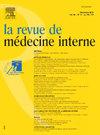Catatonie – À propos de quatre cas cliniques et revue de la littérature
IF 0.9
4区 医学
Q3 MEDICINE, GENERAL & INTERNAL
引用次数: 0
Abstract
Introduction
Catatonia is a neuropsychiatric syndrome characterized by the presence of at least three out of the twelve following signs: stupor, catalepsy, waxy flexibility, mutism, negativism, posturing, mannerisms, stereotypies, agitation, grimacing, echolalia, and echopraxia. We will describe four cases of catatonia that occurred over one year in a single medicine department.
Clinical cases
All four patients were over 60 years old. The causes of catatonia were diverse: hemorrhagic shock occurring in the context of mixed dementia, schizoaffective disorder, a severe major depressive episode, and a depressive syndrome associated with Lewy body disease. Three out of four patients were treated with electroconvulsive therapy (ECT), and all evolved towards remission. The diagnoses were consistently established by a liaison psychiatrist.
Discussion
Before the recruitment of liaison psychiatrists in the institution, this diagnosis had not been considered in the department. The cause of catatonia can be psychiatric (75 to 80% of cases) and/or non-psychiatric (20 to 25% of cases). In two thirds of organic cases, it is a condition of the central nervous system. Symptomatic treatment with benzodiazepine allows for remission of symptoms in more than two thirds of cases. In the absence of response to benzodiazepines, treatment with electroconvulsive therapy is indicated. Catatonia can progress to death, following possible complications or in cases of severe dysautonomia (malignant catatonia).
Conclusion
Catatonia is underdiagnosed and undertreated. Despite a relatively high prevalence, well-defined diagnostic criteria, and a symptomatic treatment that is often very effective, the prognosis of catatonia can be poor in the absence of treatment. Psychiatrists should be consulted whenever there is doubt regarding a clinical presentation.
[紧张症- 4例临床及文献复习]。
简介:紧张症是一种神经精神综合征,其特征是以下12种体征中至少有3种存在:麻木、猝睡、柔软、沉默、消极、姿势、举止、刻板印象、躁动、鬼脸、回声症和回声恐惧症。我们将描述四个病例紧张症发生在一个单一的医学部门超过一年。临床病例:4例患者年龄均在60岁以上。紧张症的病因多种多样:在混合性痴呆、分裂情感性障碍、严重重度抑郁发作和与路易体病相关的抑郁综合征的背景下发生的失血性休克。4名患者中有3名接受了电休克治疗(ECT),所有患者都逐渐缓解。这些诊断都是由一位联络精神科医生确定的。讨论:在该机构招募联络精神科医生之前,该科没有考虑过这种诊断。紧张症的病因可以是精神疾病(75% - 80%的病例)和/或非精神疾病(20% - 25%的病例)。在三分之二的器质性病例中,这是一种中枢神经系统的疾病。用苯二氮卓类药物对症治疗可使超过三分之二的病例症状缓解。在对苯二氮卓类药物无反应的情况下,需要电休克治疗。紧张症在可能的并发症或严重的自主神经异常(恶性紧张症)的情况下可进展至死亡。结论:紧张症未被充分诊断和治疗。尽管发病率相对较高,诊断标准明确,对症治疗通常非常有效,但在缺乏治疗的情况下,紧张症的预后可能很差。当对临床表现有疑问时,应咨询精神科医生。
本文章由计算机程序翻译,如有差异,请以英文原文为准。
求助全文
约1分钟内获得全文
求助全文
来源期刊

Revue De Medecine Interne
医学-医学:内科
CiteScore
0.70
自引率
11.10%
发文量
526
审稿时长
37 days
期刊介绍:
Official journal of the SNFMI, La revue de medecine interne is indexed in the most prestigious databases. It is the most efficient French language journal available for internal medicine specialists who want to expand their knowledge and skills beyond their own discipline. It is also the main French language international medium for French research works. The journal publishes each month editorials, original articles, review articles, short communications, etc. These articles address the fundamental and innumerable facets of internal medicine, spanning all medical specialties. Manuscripts may be submitted in French or in English.
La revue de medecine interne also includes additional issues publishing the proceedings of the two annual French meetings of internal medicine (June and December), as well as thematic issues.
 求助内容:
求助内容: 应助结果提醒方式:
应助结果提醒方式:


